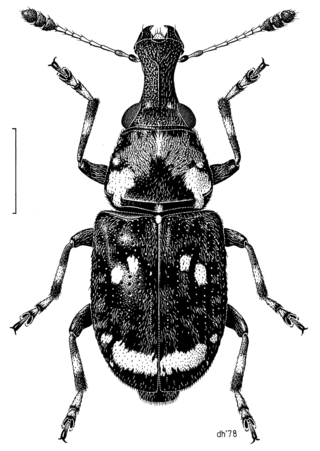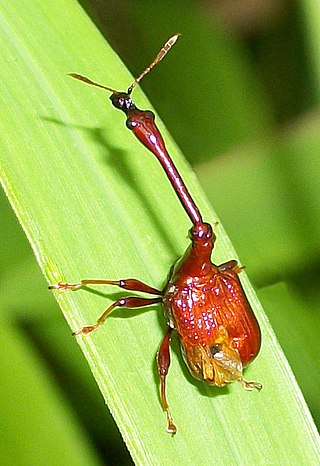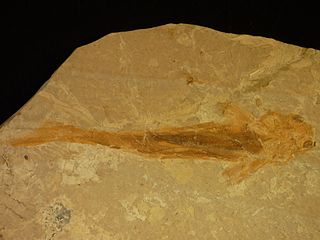Related Research Articles

Weevils are beetles belonging to the superfamily Curculionoidea, known for their elongated snouts. They are usually small – less than 6 mm in length – and herbivorous. Approximately 97,000 species of weevils are known. They belong to several families, with most of them in the family Curculionidae. It also includes bark beetles, which while morphologically dissimilar to other weevils in lacking the distinctive snout, is a subfamily of Curculionidae. Some other beetles, although not closely related, bear the name "weevil", such as the biscuit weevil, which belongs to the family Ptinidae.

The Trachypachidae are a family of beetles that generally resemble small ground beetles, but that are distinguished by the large coxae of their rearmost legs. There are only six known extant species in the family, with four species of Trachypachus found in northern Eurasia and northern North America, and two species of Systolosoma in Chile and Argentina. They were much more diverse in the past, with dozens of described species from the Mesozoic.

Belidae is a family of weevils, called belids or primitive weevils because they have straight antennae, unlike the "true weevils" or Curculionidae which have geniculate (elbowed) antennae. They are sometimes known as "cycad weevils", but this properly refers to a few species from the genera Parallocorynus and Rhopalotria.

Bittacidae is a family of scorpionflies commonly called hangingflies or hanging scorpionflies.

Osmylidae are a small family of winged insects of the net-winged insect order Neuroptera. The osmylids, also called lance lacewings, stream lacewings or giant lacewings, are found all over the world except North and Central America. There are around 225 extant species.

Anthribidae is a family of beetles also known as fungus weevils. The antennae are not elbowed, may occasionally be longer than the body and thread-like, and can be the longest of any members of Curculionoidea. As in the Nemonychidae, the labrum appears as a separate segment to the clypeus, and the maxillary palps are long and projecting.

The Attelabidae is a widespread family of weevils. They are among the primitive weevils, because of their straight antennae, which are inserted near the base of the rostrum. The prothorax is much narrower than the base of the elytra on the abdomen. Attelabidae and the related family Rhynchitidae are known commonly as the leaf-rolling weevils. Rhynchitidae may be treated as subfamily Rhynchitinae of the Attelabidae.

Nemonychidae is a small family of weevils, placed within the primitive weevil group because they have straight rather than geniculate (elbowed) antennae. They are often called pine flower weevils. As in the Anthribidae, the labrum appears as a separate segment to the clypeus, and the maxillary palps are long and projecting. Nemonychidae have all ventrites free, while Anthribidae have ventrites 1-4 connate or partially fused. Nemonychidae lack lateral carinae on the pronotum, while these are usually present, though may be short, in Anthribidae.

Nannopterygius is an extinct genus of ophthalmosaurid ichthyosaur that lived during the Middle Jurassic to the Early Cretaceous. Fossils are known from England, Kazakhstan, Russia, and Norway and six species are currently assigned to the genus.

Peipiaosteus is an extinct genus of prehistoric chondrostean ray-finned fish. Its fossils are found in the Early Cretaceous Jiufotang Formation, Pani Lake, Liaoning Province, China.
Pseudobrienia is an extinct genus of beetles which existed in what is now Kazakhstan during the middle Late Jurassic epoch. It was described by A. A. Legalov in 2012, and the type species is P. rasnitsyni.
This list of fossil arthropods described in 2012 is a list of new taxa of trilobites, fossil insects, crustaceans, arachnids and other fossil arthropods of every kind that have been described during the year 2012. The list only includes taxa at the level of genus or species.

Zamites is a genus of sterile foliage known from the Mesozoic of North America, Europe, India and Antarctica through the Eocene of North America. It was erected as a form taxon for leaves that superficially resembled the extant cycad Zamia, however it is now believed to belong to a similar but phylogenetically different group, the cyacadeoids (Bennettitales). The fronds are linear or lanceolate in shape, and pinnately compound, with pinnae with parallel veins and smooth margins, and symmetrical and constricted at the base where they are attached obliquely to the upper surface of the rachis. It has been interpreted as a Bennettitalean plant in the family Williamsoniaceae. It is associated with the ovulate cone Williamsonia and male cone Weltrichia.

Mesophyletidae is an extinct family of weevils known from a number of genera preserved in Cretaceous amber. The family was first described as a subfamily in the extant family Caridae, and subsequently raised to family status in 2018.
2015 in paleoentomology is a list of new fossil insect taxa that were described during the year 2015, as well as other significant discoveries and events related to paleoentomology that were scheduled to occur during the year.

Archisargidae is an extinct family of brachyceran flies known from the Jurassic and Cretaceous periods. It is part of the extinct superfamily Archisargoidea. Most members of the family are known from the Callovian-Oxfordian Daohugou biota of Inner Mongolia, China, and the equivalently aged Karabastau Formation of Kazakhstan. The family has been found to be paraphyletic with respect to Eremochaetidae in a cladistic analysis.
Kazakhstanosaurus is an extinct genus of undorosaurid ichthyosaur from the Late Jurassic of Kazakhstan and Russia. Two species are known: the type, K. efimovi, and K. shchuchkinensis, both named and described in 2021.
This paleoentomology list records new fossil insect taxa that were described during the year 2014, as well as notes other significant paleoentomology discoveries and events which occurred during that year.
Geinitziidae is an extinct family of polyneopteran insects, known from the Permian to Cretaceous. They are currently considered to be members "Grylloblattida" a poorly defined group of extinct insects thought to be related to modern ice crawlers (Grylloblattidae). Other authors place them in the extinct order Reculida. Unlike modern ice crawlers, which are wingless, they had large wings, bearing a superficial resemblance to cockroaches, and are thought to have been day-active above ground predators.
This list of 2023 in paleoentomology records new fossil insect taxa that are to be described during the year, as well as documents significant paleoentomology discoveries and events which occurred during that year.
References
- ↑ A. A. Legalov (2012). "New Obrieniidae from the Jurassic of Kazakhstan (Coleoptera, Obrienioidea)". Paleontological Journal. 46 (1): 73–78. doi:10.1134/S0031030112010091.